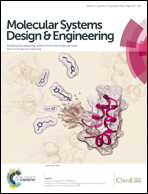Block copolymer compatibilizers for ternary blend polymer bulk heterojunction solar cells – an opportunity for computation aided molecular design
Abstract
In this review article, we discuss some recent developments in the context of the use of block copolymers (BCP) as compatibilizers in ternary blend organic photovoltaic devices. At the outset, we review some of the salient experimental studies and highlight the successes achieved in using BCPs to improve the long-term stability of the donor–acceptor based devices. We suggest that the physico-electro-chemical properties of BCP compatibilizers may be targeted as a hitherto less-explored handle to modulate the morphology and device characteristics of such systems. In this regard, we propose that coarse-grained computer simulation tools, despite being limited in their ability to capture complex interaction features and crystallization phenomena, can serve as a guide to narrow and/or identify parametric regions where morphologies desirable for better exciton and charge transport can be achieved. Furthermore, we suggest that the output of the morphological predictions can be combined with coarse-grained device simulation approaches to identify the overall photovoltaic properties of the ternary blends containing such BCP compatibilizers. Together, such computational studies can serve to connect the molecular structure and electronic properties of the BCP to the overall device properties and, thereby, to enable a rational molecular design of BCP compatibilizers for organic photovoltaic devices.


 Please wait while we load your content...
Please wait while we load your content...